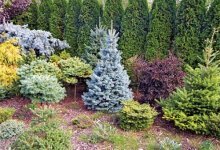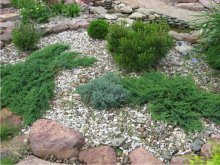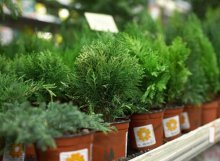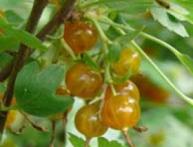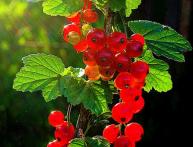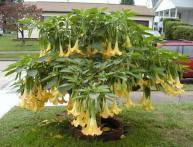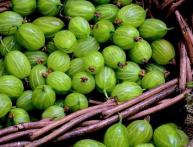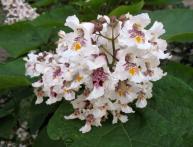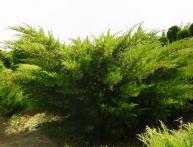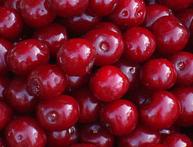Dwarf conifers: how to choose and plant beautifully on your site
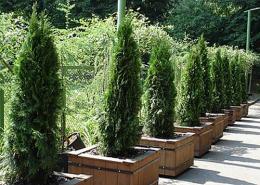
Currently landscape design is developing at tremendous speed, and the latest fashionable trend is to plant dwarf coniferous trees on your site. Many years ago there was an opinion that coniferous trees should not be grown on your plots, as they could only bring misfortune to your home. However, these are all fairy tales, and experts have long proven that coniferous plants have a large number of positive qualities.
Dwarf coniferous trees perfectly purify the air, thanks to the high content of phytoncides; staying in such an area will be useful for people who have any lung diseases or problems with the upper respiratory tract. Coniferous dwarf trees have a beautiful appearance. A well-groomed hedge made from plants of this type cannot compare in its beauty with any, even the most fashionable fence.
Content:
Interesting things about dwarf conifers
Many people wonder where these “gnomes” even came from. This breed is the long-term work of breeders who, as a result of crossing and making changes to each species, managed to create such an ornamental plant.
It is almost impossible to grow plants yourself from ordinary seeds, since they do not retain all the data about the dwarf variety, and as a result, an ordinary, tall spruce grows. Such trees for landscape design can only be purchased as small seedlings, which will then grow and develop in your garden plot.
Before purchasing a dwarf spruce, you should carefully study the characteristics of its type, the shape of the crown, and most importantly, the rules of care. The artificially bred variety does not have a high level of resistance to negative environmental factors, so such a plant needs special care to prevent its sudden death. Also, you need to make sure that the root system of the tree is not damaged in any way. Therefore, before purchasing, you should carefully study all the characteristics of the tree.
The cost of dwarf ephedra compared to others coniferous trees, quite high. But it is worth noting that before going on public sale, this small tree is grown for several years in a special nursery. On average, it will take 2 to 3 years to grow a 10 cm tall spruce tree. In general, caring for such a tree is not difficult, the main thing is to follow all the specifics of watering and fertilizing.
Dwarf conifers when designing plots

Dwarf conifers today are presented in a wide range. Each of these trees has a main feature - the possibility of using dwarf conifers in the design of a garden plot is varied, which is why they have gained wide popularity among landscape designers.
So small conifer tree will be an excellent decoration for a flower garden, alpine hill, flower bed.Since such trees are characterized by slow growth, it is possible to predict in advance what a particular object on the site will look like in a few years.
The small size of coniferous trees makes it possible to use them in small summer cottages and garden plots. Some even grow them on the balcony. Dwarfs are not picky about soil and live very well next to other plants.
Secrets of creating compositions
In order for the dwarf conifer to appear before you in all its glory, you can use two main methods:
- Plant the conifer so that it acts as a tapeworm. That is, it will be a single tree, which will be complemented by harmonious plants and textures around it.
- Create small plantings of several trees that can serve as a small fence to divide a large area into several zones.
Therefore, the main task that the designer must solve first when creating a landscape composition with the participation of dwarfs is the selection of such neighboring plants, among which the “kids” will not get lost, but, on the contrary, will show all their beauty. These plants should be quite modest.
Their main task is to emphasize the color and texture of the needles, the shape and density of the crown:
- Dwarf conifers of round and columnar shape are combined with carpet-type plants (mosses, creeping sedums, young plants), squat grasses, alyssums, and catnips.
- Creeping conifers or weeping forms (cushion and weeping spruces, creeping junipers and thujas, Himalayan pine) will look impressive against the background of plants with curly leaves pressed tightly to the ground. Such neighbors include silver stachys, small periwinkle, thyme, tenacious, and small-leaved hostas.
- Raised arrangements or plants in a trough are a great option to slightly raise the level of plants in the space, which will focus the attention on them.
If someone has an old trough lying around, then its bottom needs to be holed in several places so that there is drainage excess water, thawed or after watering. We install it on a well laid layer of stones, and also decorate the sides with stones. Maybe someone will be able to do this without cement mortar, but if the structure is shaky, then the mortar will help.
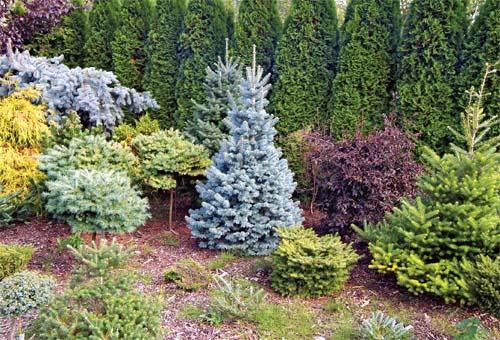
Next, you need to put drainage on the bottom, you can also use broken bricks, cut branches from trees, which will add looseness. And fill the trough with soil that is suitable for coniferous plants. Remember, it's supposed to be sour? Great!
We plant dwarf coniferous plants in the ground, and in the spaces between them you can plant some beautiful flowering or decorative foliage plants. For example, you can plant young rosettes along the very edge. Don't forget that other plants should not be taller than conifers!
Nuances of cultivation
Dwarf conifers appeared in our gardens relatively recently, but quickly fell in love with many gardeners. At the same time, there were certain mistakes in their breeding, associated with a misunderstanding of what place they should be given in the garden.
The reason was that under the concept of “dwarf conifers” were united different types, which differed greatly in growth rates, which is why it often turned out that one dwarf species grew by 2-3 cm during the year, and another by a couple of tens of centimeters. Naturally, due to such a difference in growth, the initially planned plantings eventually lost their intended outlines, and the need for new transplants and redevelopments arose.
Unfortunately, the trend of inaccurate use of concepts continues to this day, both in the literature and among sellers.
Tips for buying dwarf conifers
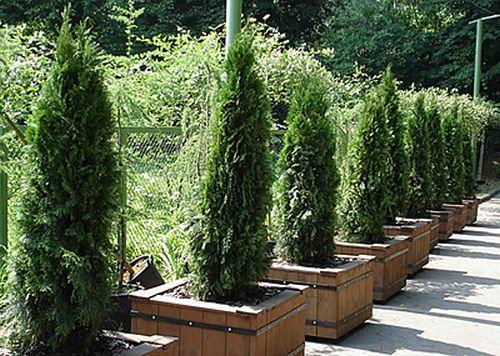
General recommendation: first find out everything about the dwarf, then buy and plant. The main sources of information for you will be a sales consultant, the Internet, and advice from friends who have experience with dwarf conifers.
If the necessary information from these sources is insufficient, then you can rely on a visual inspection of the plant and examination of the label. By eye, you can try to determine the growth rate of the past and current year in the conductor, or in the side shoots.
You should also take a closer look at the label. A good label indicates the genus, species, variety, plants - it certainly should be in Latin. Ideally, the nursery in which the plant was grown is also indicated.
To choose the right dwarf coniferous tree for your garden, it is recommended to determine which category from the classification described above the seedling you like belongs to. Knowing what crown shape characteristic of this species, it will be easier to estimate the parameters of the tree in a few years and, taking this into account, choose a suitable place for it in the landscape of your garden.
The wisdom of planting dwarf coniferous plants:
Interesting information about the vegetable garden

